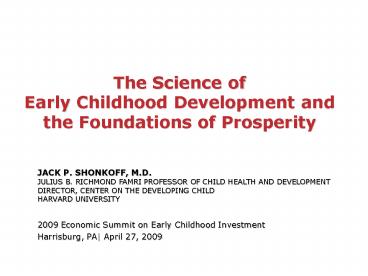PowerPoint Presentation - The Science of Early Childhood Development - PowerPoint PPT Presentation
1 / 22
Title:
PowerPoint Presentation - The Science of Early Childhood Development
Description:
Brief increases in heart rate, mild elevations in stress hormone levels. ... Normal. Toxic. stress. Prefrontal Cortex and. Hippocampus. Typical neuron many ... – PowerPoint PPT presentation
Number of Views:288
Avg rating:3.0/5.0
Title: PowerPoint Presentation - The Science of Early Childhood Development
1
The Science of Early Childhood Development and
the Foundations of Prosperity
JACK P. SHONKOFF, M.D. JULIUS B. RICHMOND FAMRI
PROFESSOR OF CHILD HEALTH AND DEVELOPMENT DIRECTOR
, CENTER ON THE DEVELOPING CHILD HARVARD
UNIVERSITY
2009 Economic Summit on Early Childhood
Investment Harrisburg, PA April 27, 2009
2
Decades of Science from Many Disciplines All
Point to the Same Conclusion
The healthy development of children provides a
strong foundation for healthy and competent
adulthood, responsible citizenship, economic
productivity, strong communities, and a
sustainable society.
3
Five Numbers to Remember
700 per second 18 months 21 ratio 90-100
percent 31 odds
4
Neural Circuits are Wired in a Bottom-Up
Sequence (700 synapses formed per second in the
early years)
Language
Higher Cognitive Function
Sensory Pathways (Vision, Hearing)
FIRST FIVE YEARS
1 2 3 4 5 6 7 8 9 10 11 1 2 3 4 5 6 7 8 9 10 11
12 13 14 15 16 17 18 19
Years
Months
Source C.A. Nelson (2000)
5
Barriers to Educational Achievement Emerge at a
Very Young Age
1200
1000
College Educated Parents
800
Working Class Parents
Cumulative Vocabulary (Words)
600
Welfare Parents
400
200
16 mos.
24 mos.
36 mos.
Childs Age (Months)
Source Hart Risley (1995)
6
Significant Adversity Impairs Development in the
First Three Years
100
80
Children with Developmental Delays
60
40
20
1-2
3
5
4
6
7
Number of Risk Factors
Source Barth et al. (2008)
7
Risk Factors for Adult Heart Disease are Embedded
in Adverse Childhood Experiences
3.5
3
2.5
Odds Ratio
2
1.5
1
0.5
0
1
2
3
4
5,6
7,8
Adverse Experiences
Source Dong et al, (2004)
8
Early Experiences Affect the Architecture of the
Developing Brain
9
Brains and Skills Are Shaped by the Serve and
Return Nature of Human Interaction
10
Cognitive, Emotional, and Social Capacities Are
Inextricably Intertwined Within the Architecture
of the Brain
11
The Brain Architecture of Memory and Learning
12
The Brain Architecture of Anxiety and Fear
13
Science Tells Us that Early Life Experiences Are
Built Into Our Bodies
Research on the biology of stress illustrates how
threat raises heart rate, blood pressure, and
stress hormone levels, which can impair brain
architecture, immune status, metabolic systems,
and cardiovascular function.
14
Three Levels of Stress
Positive Brief increases in heart rate, mild
elevations in stress hormone levels.
Tolerable Serious, temporary stress responses,
buffered by supportive relationships.
Toxic Prolonged activation of stress response
systems in the absence of protective
relationships.
15
Toxic Stress Changes Brain Architecture
Typical neuron many connections
Normal
Toxic stress
Damaged neuron fewer connections
Prefrontal Cortex and Hippocampus
Sources Radley et al. (2004)
Bock et al. (2005)
16
Research Findings Can Guide Policies
Supportive relationships and positive learning
experiences begin at home but can also be
provided through a range of services with
well-documented effectiveness factors. A
balanced approach to emotional, social,
cognitive, and language development will best
prepare children for success in school, the
workplace, and the community. Highly
specialized interventions are needed as early as
possible for children experiencing tolerable or
toxic stress.
17
Preventive Intervention is More Efficient and
Produces More Favorable Outcomes Than Later
Remediation
Programs targeting the earliest years
Rates of return to human capital investment
Preschool programs
K-12 schooling
College, job training
B-3
4-5
6-18
19
Age
Heckman, J. (2007)
18
Cost/Benefit Analyses Show Positive Returns Two
Early Childhood Programs Demonstrate Range of
Benefits to Society
16.14
18
Total Return per 1 Invested
16
14
Returns to Society
12
11.35
4 x
Returns to Individuals
10
4.10
6
Crime-cost savings
0.16
1.55
4
Special education, welfare, income taxes
1.5 x
2.28
2
3.24
1.57
Increased earnings
Perry Preschool (through age 40)
Abecedarian Project (through age 21)
19
Invest Now or Pay More LaterGetting it right
early is less costly and more effective than
dealing with problems later in life.
1.94 billion
2 billion
30m
1.5 billion
1 billion
750 million
414m
500 million
1.55
Federal in PA (2007)
1,906m
PA State (2007)
336m
Corrections (346,268 served)
Early Care and Education (275,534 served)
20
Advancing an Effective Policy Agenda
Build an appropriately skilled early childhood
workforce whose expertise matches the needs of
the children and families it serves. Invest in
evidence-based programs that are implemented
well. Leverage the power of bipartisan support
and public-private partnerships. View expanding
opportunities for children as a moral
responsibility and a wise social and economic
investment.
21
Five Numbers to Remember
700 per second 18 months 21 ratio 90-100
percent 31 odds
22
www.developingchild.harvard.edu































